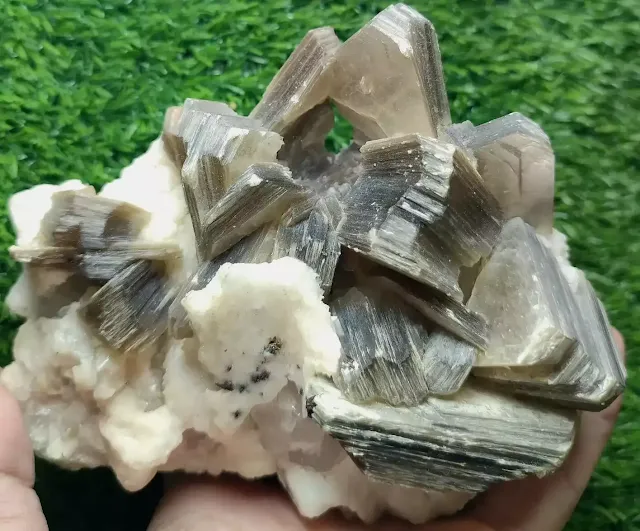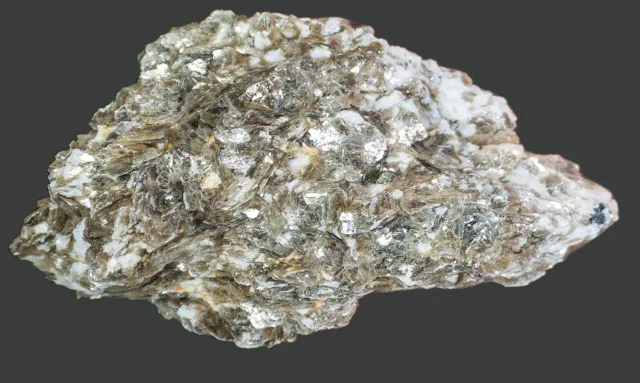Muscovite: Properties, Uses, Occurrence
Muscovite is the most abundant mica mineral, a potassium aluminum phyllosilicate with the chemical formula KAl₂(AlSi₃O₁₀)(F,OH)₂. It belongs to the mica group, a family of sheet silicate (phyllosilicate) minerals known for their distinctive layered crystal structure and perfect basal cleavage.
Typically colorless, silvery, or pale brown, muscovite exhibits a glassy to pearly luster and can easily split into thin, flexible, transparent sheets. This physical property—perfect cleavage along the basal plane—makes muscovite highly valuable in industrial, scientific, and historical contexts.
Also known as common mica, potassium mica, or silver mica, muscovite is used in a wide range of applications due to its excellent insulating properties and thermal stability. It is essential in the electronics industry, where it is used in capacitors and insulators.
 |
| Bladed Muscovite crystals. |
Muscovite is widespread and commonly occurs in igneous, metamorphic, and sedimentary rocks. It forms in granite, pegmatites, schists, and some shales, especially those rich in aluminum. It is a useful indicator of metamorphic grade and is often associated with minerals like quartz, feldspar, and biotite.
The name muscovite comes from “Muscovy glass,” a term used in medieval Russia where clear sheets of muscovite were used as window glass due to their transparency and durability.
Muscovite can form exceptionally large sheets. The largest recorded muscovite crystal, found in India, measured 5 meters by 3 meters and weighed 85 tons!
Muscovite Properties
Composition: A hydrated phyllosilicate mineral composed primarily of potassium, aluminum, silicon, and oxygen. KAl₂(AlSi₃O₁₀)(OH,F)₂, commonly simplified as KAIF₃Si₃O₁₀(OH,F)₂
Muscovite Physical Properties
- Color: Colorless, white, or translucent, often with tints of gray, brown, green, yellow, violet, or red. The color can vary depending on impurities and trace elements.
- Luster: Pearly or vitreous - The pearly luster is due to its layered structure, while the vitreous luster appears on the cleavage surfaces.
- Crystal System: Monoclinic - The crystals have a single plane of symmetry and two non-perpendicular axes of unequal lengths.
- Streak: White - The color of the powder produced when scratched.
- Hardness: 2-2.25 on the Mohs scale - Relatively soft, but its flexibility and toughness make it ideal for certain applications.
- Cleavage: Perfect basal cleavage - Can be easily split into thin, flexible sheets along one direction.
- Crystal habit: Muscovite crystal habit is typically tabular, forming thin, flat, pseudo-hexagonal crystals. It also occurs as platy, micaceous flakes, foliated masses, or book-like aggregates.
- Density: 2.76-3 g/cm³ - A relatively dense mineral compared to other micas.
- Transparency: Translucent to transparent - The degree of transparency depends on the thickness and presence of impurities.
- Fracture: Conchoidal - When broken apart, it creates smooth, curved surfaces like shells.
- Specific Gravity: 2.76-3.00 - Slightly heavier than water.
- Solubility: Insoluble in most acids and alkalis - Resistant to chemical weathering.
- Magnetism: Non-magnetic - Does not attract or repel magnets.
 |
| Large Muscovite crystals |
Muscovite Optical Properties
- Fluorescence: Weak to moderate fluorescence under long-wave ultraviolet light - Can appear blue or green.
- Pleochroism: Weak - Slight variations in color depending on the viewing direction due to its layered structure.
- Refractive Index: 1.56-1.59 - A measure of how light bends when passing through the mineral.
Muscovite Additional Properties
- Inclusions: Quartz, feldspar, tourmaline, garnet, and other minerals can be present as inclusions within muscovite.
- Electrical insulation: Muscovite possesses exceptional electrical insulating properties, making it useful in electronic components.
- Heat resistance: The mineral is resistant to high temperatures, making it suitable for refractory linings and other heat-related applications.
 |
| Large Muscovite sheets, From Minas Gerais, Brazil Photo: JMIMPORT |
How is Muscovite Formed
Crystallization in Magma
As molten rock (magma) cools and solidifies, minerals start to crystallize out. When the conditions are right (sufficient potassium, aluminum, and silicon), muscovite can form alongside other minerals like quartz and feldspar. This process typically occurs in igneous rocks like granites and pegmatites, where large crystals of muscovite can sometimes be found.
Metamorphism of Rocks
When existing rocks are subjected to extreme heat and pressure during metamorphism, existing minerals can transform into new ones. This metamorphic process is another crucial route for muscovite formation. Clay minerals within sedimentary rocks or feldspars in igneous rocks can transform into muscovite under the metamorphic crucible. This process often results in muscovite-rich metamorphic rocks like schists and gneisses.
Muscovite Uses
Muscovite, with its shimmering beauty and unique properties, shines in a variety of applications. Here's a closer look at how this versatile mineral is utilized across different fields:
Electronics:
Insulator: Muscovite's exceptional electrical insulating properties make it a crucial component in capacitors, transistors, and other electronic devices. It helps regulate and direct electrical currents, ensuring safe and efficient operation.
Cosmetics:
Shimmer and Shine: Finely ground muscovite adds a sparkly, pearlescent effect to eyeshadows, highlighters, and other makeup products. It enhances the product's appearance and reflects light for a radiant glow.
Paints and Coatings:
Brightness and Durability: Muscovite powder contributes to the brightness, opacity, and fire-retardant properties of paints and coatings. It improves the overall quality and functionality of these materials.
Jewelry:
Captivating Adornment: Large, clear muscovite crystals can be cut and polished into beautiful cabochons or beads for earrings, necklaces, and other jewelry pieces. Its shimmering nature creates stunning and unique accessories.
Fireproofing Materials:
Heat Resistance: Muscovite's ability to withstand high temperatures makes it suitable for insulating linings in furnaces, fireplaces, and ovens. It helps prevent heat transfer and protects surrounding materials from fire damage.
 |
| Yellow muscovite With Quartz Specimens From Skardu Pakistan. Photo: Hamza Munir |
Other Applications:
- Rubber Production: Muscovite acts as an additive in rubber production, improving its strength and heat resistance.
- Industrial Lubricant: In specific industrial applications, muscovite powder can be used as a lubricant due to its smooth, platy structure.
- Plastics and Ceramics Filler: Crushed muscovite can be used as a filler in plastics and ceramics, reducing production costs and adding structural strength.
- Drilling Mud and Soil Amendments: Muscovite powder finds its way into drilling mud used in oil and gas exploration, and as a soil amendment for certain agricultural applications.
 |
| Muscovite Mica Cluster |
Where is Muscovite Found
Muscovite distribution reflects the geological processes that give rise to this versatile mineral. Here's a closer look at where you might encounter muscovite in the world:
Igneous Rocks:
- Granites and pegmatites: These coarse-grained igneous rocks, formed from the crystallization of magma, often contain large crystals of muscovite. Pegmatites, in particular, can host exceptionally large muscovite crystals, some reaching several meters in size.
- Granitic gneisses: These metamorphic rocks, formed by the transformation of granites, can also inherit muscovite from their parent rock.
- Schists and gneisses: These rocks, formed by the metamorphism of sedimentary or igneous rocks under high pressure and temperature, often contain significant amounts of muscovite. The mineral's presence contributes to the characteristic foliation and layering of these rocks.
- Migmatites: These complex rocks, showcasing the blending of igneous and metamorphic processes, can contain patches of muscovite, often intermingled with granitic material.
 |
| Muscovite schist |
Specific Geographic Regions:
- Brazil: Minas Gerais state, particularly the Jenipapo district, is renowned for its large, transparent muscovite crystals prized for their optical quality and use in decorative objects.
- India: The Indian subcontinent, especially mica belts in Andhra Pradesh, Jharkhand, and Rajasthan, has been a historical source of muscovite, valued for its electrical insulating properties.
- Madagascar: Andranondambo district is known for its exceptional pegmatites containing various mica minerals, including muscovite, prized for their unique colors and textures.
- Russia: The Ural Mountains region possesses a long history of muscovite mining, with deposits near Kyshtym and Miass still yielding valuable mica flakes.
- United States: Maine and South Dakota have historically been important sources of muscovite in North America, with pegmatites in these regions yielding commercially valuable mica sheets.
 |
| Red muscovite mica. Photo: James St. John |
 |
| Muscovite |
In conclusion, muscovite transcends its captivating aesthetics to offer a compelling illustration of mineral genesis, diverse material properties, and multifaceted utility. From electronics and fireproofing to cosmetics and potential advancements in water purification and energy storage, muscovite continues to spark scientific curiosity and technological innovation.









